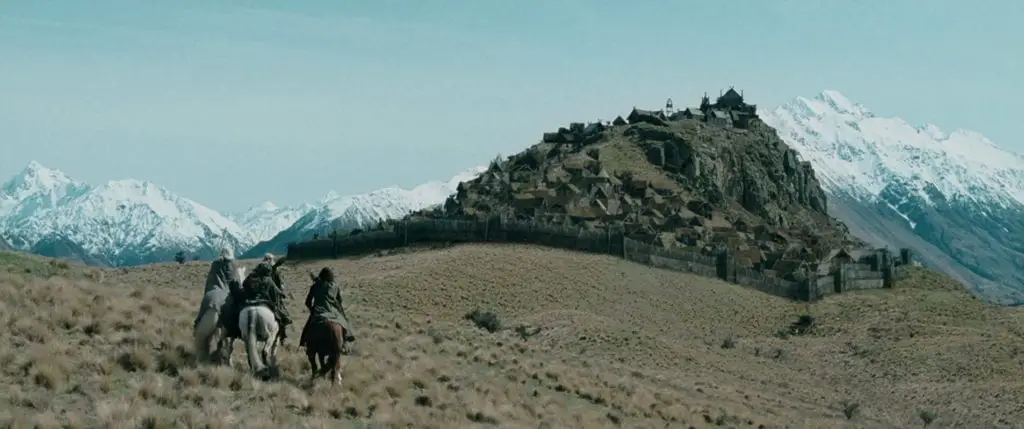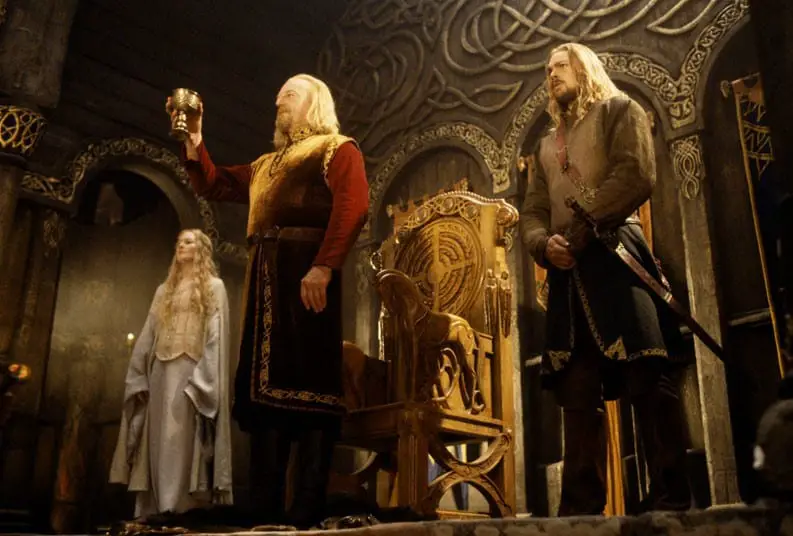Fifteen years on, it’s hard for me to convey how much the film adaptations of The Two Towers (and later, The Return of the King) meant to me when they first came out. I inscribed a year-long countdown studiously on my calendar. My family’s newly-obtained dial-up internet was too slow to watch movie trailers, so I studied the frame-by-frame analysis on theonering.net. By the time Return of the King rolled around, that no longer sufficed, so I made the questionable choice to go see Secondhand Lions , a movie about Haley Joel Osmont and lions, I guess. It was put out by New Line Cinema, though, and I knew I’d get a trailer at the start. The things we did before broadband.
All of this to say: I loved this movie when I was in high school. It meant the world to me. And there are moments in it that I’ll probably hold dear forever. But. With the perspective granted by distance, The Two Towers is not a great film.
Capturing Middle-earth
Let’s start with the good, though. As expected from Fellowship, The Two Towers looks wonderful. Part of this is just New Zealand, of course. The opening shots of the Misty Mountains bathed in a pinkish sunrise are almost painfully pretty. The sense of Rohan being beautiful and green and slightly too empty is captured well-in both the choice of landscape itself and Peter Jackson’s choice to film Aragorn & Co. from far away, so that the grasslands almost seem to swallow them.
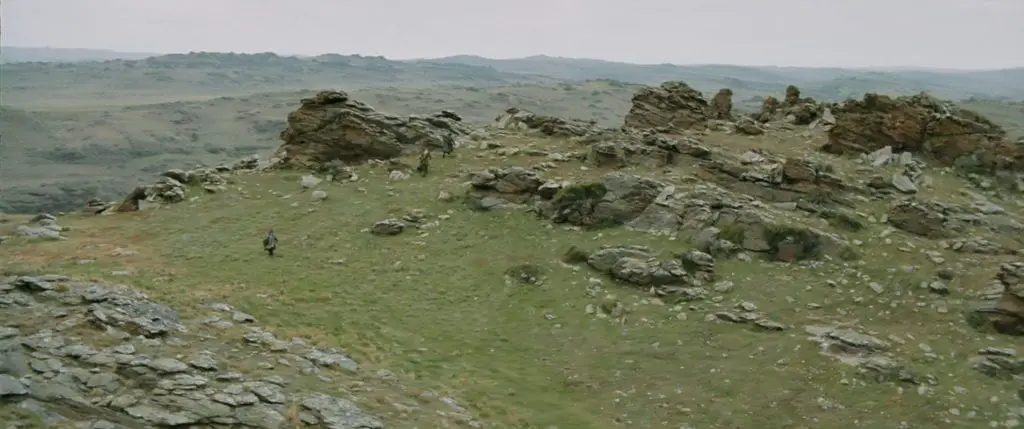
It’s indicative of Jackson’s directing style, which can make inspired use of space. Take this early shot, of Gandalf and the Balrog falling into the depths of Moria like a candle flame.
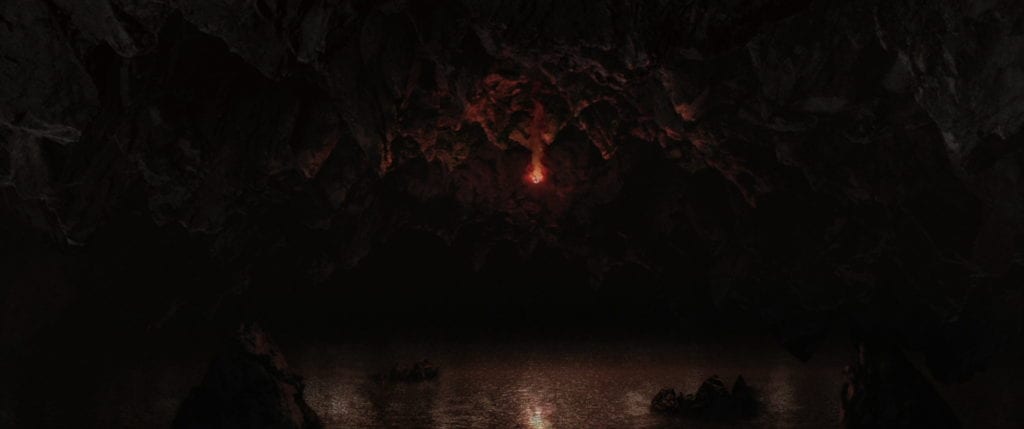
It’s a great, wordless way to convey that vastness of Moria. The previous frames held tight to Gandalf, all movement and fire and the massive size of the Balrog. The sudden pull away, as they fall into immense darkness, is startling and a nice reminder of the scale—both physical and narrative—of Middle Earth.
The real star of the show, though, is the film’s production design (good job, Grant Major! You never get enough credit!). Rohan in particular is beautifully detailed and crafted. Major’s team built Edoras atop a cliff face over the course of nine months and is about as perfect an Edoras as you could hope to get. The interior is just as good, clearly basking in the Anglo-Saxon inspiration of Tolkien’s Rohan. It’s all dark woods, deep reds, and Celtic knots.
Casting
Beyond the film’s general aesthetics, the cast remains strong as well. Dominic Monaghan and Billy Boyd keep Merry and Pippin (respectively) afloat, despite having the slightest imaginable story arc in this film. They seem genuinely thrilled to be around each other, and the energy they pour into their performances fights valiantly against the dead weight of their scenes.
Ian McKellan’s return as Gandalf is a breath of fresh air. More than anyone else, McKellan manages to nail the nuance with which Tolkien imbued his character. He’s a wonderful flurry of concern, short-temperedness, and bright humor. He also crushes it whenever he delivers straight-from-the-book dialogue.
The new arrivals are the real stars, though. Karl Urban, Miranda Otto, and Bernard Hill are all really lovely, despite the short shrift given to Eómer (Urban) and Théoden (Hill). Otto in particular manages to ground Eówyn in a coldness and desperation that’s key to her character. Brad Dourif gets the short end of the stick as Grima, as Peter Jackson seems to have told him to play Evil Grease Boy and left it at that.
And Gollum! I’d love to hear what you all think of the realization of Gollum, but I was really pleased. The elastic, frenetic performance given by Andy Serkis (and his CGI team) really carries it. It helps that he keeps quite a bit of his book dialogue, as Gollum’s syntax goes so far in building his character. It’s both wonderful and frustrating: Gollum is a great example of a character crafted with nuance through careful use of syntax, body language, and efficient storytelling. It’s just a reminder of how rare that is with the rest of the characters.
Which brings us to the inevitable ‘but’. The Two Towers is beautifully crafted, scored, and acted. It’s also poorly written.
The Two Towers as Adaptation
I mean, I get it. Middle chapters are hard. Especially when you’re adapting a middle chapter with three concurrent narratives. I’d be willing to forgive a lot. But it was hard for me to watch this film and not think that it largely fails as a thematic adaptation of The Two Towers.
We talked last year about how one of Fellowship’s key failings was its tendency toward externalization. Fine, it’s a film. A visual medium. But it does it in all the wrong ways. It externalizes the story’s conflict to such an extent that for the vast majority of the story, the characters are relentlessly passive. Everyone follows someone else, is carried by someone else, reacts to an external threat. This is both boring and wildly against the spirit of The Two Towers, which is about nothing if not interior conflict and the centrality of choice. The choice to externalize results in lazy characterizations, lazy directing, and an early hint of Peter Jackson’s looming tendency to bloat his stories into inefficacy.
Meduseld
Let’s explore this with an example. Nearly everything that is wrong with The Two Towers is encapsulated in the scene where Gandalf approaches the aged, decrepit Théoden in Meduseld.
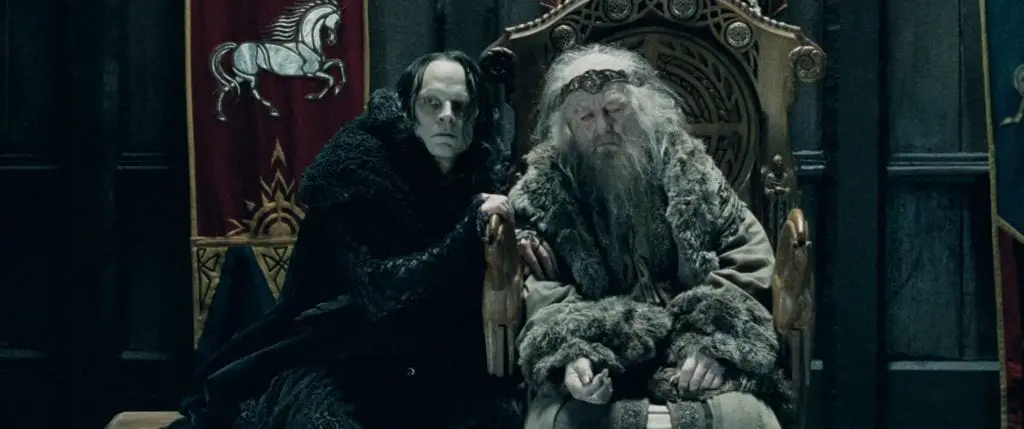
This should be a great, cinematic scene. Ian McKellan gets some solid book dialogue to deliver. It’s a key moment of choice: Théoden chooses action and hope over fear and despair. It should be a moving moment, and it’s an interior choice that’s easy to convey through visual means. Tolkien does it all the work for Jackson.
And it would be easy to have used the previous scenes in Rohan to create meaningful tension. There is an undercurrent of involvement vs. evasion that runs through Tolkien, and it is especially present in this scene. Wormtongue isn’t just Greasy Evil Boy, he is giving Théoden poor but tempting advice. He’s telling him that the world is too dangerous, that entering into the fray would only bring strife and sadness. It’s an easy message to deliver, as Théoden’s son has just died. It’s a choice that underlies of Théoden’s character for the rest of the story, and when he has to make sacrifices, it makes them reverberate with much more meaning.
Instead, the confrontation in Meduseld becomes a remarkably lazy scene. It’s hard to watch it without coming to the conclusion that Jackson didn’t possess the faith in the story or characters to let a scene unfold without cramming it full of obvious, hamfisted action. An entirely pointless skirmish occurs in the background, as Aragorn, Legolas, and Gimli punch their way out of a sword fight. Théoden is magically possessed and makes no choice at all, but simply sits there as wizards telepathically fight over him.
This should be an emotional fulcrum of the entire story, but instead conveys absolutely nothing of thematic importance. The only information to come out of the scene is that Gandalf is stronger than Saruman now, something that was already demonstrated through earlier dialogue.
Lazy Characterizations
It’s not, unfortunately, an anomaly. The nuance has been stripped out of most of these characters, and beyond what would be necessary for the constraints of time. This was a flaw in Fellowship too, but a survivable one. With the nine of them on a linear journey, the audience could derive plenty of enjoyment from seeing archetypes and tropes bounce off of each other. Split up, the cracks quickly start to show.
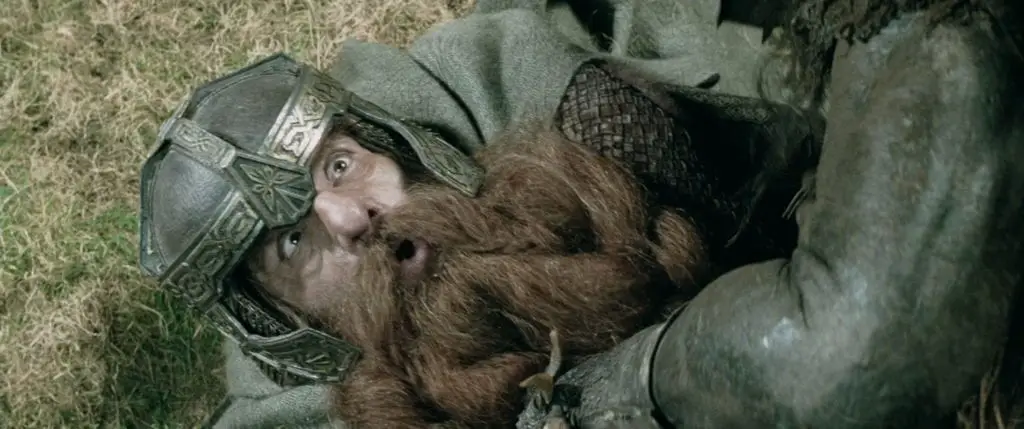
The tendency to make the hobbits almost unbearably dumb for the sake of comic relief continues apace, to the extent that I felt a wave of gratitude when Merry knew what an Ent was. Pippin inexplicably decides to give up and go home at one point, solely to set up his “plan” that does little but make the Ents look dumb. Sam’s complex characterization in The Two Towers translates into Sean Astin yelling a lot. Gimli joins their ranks, and I’m not sure he says anything all movie that is not a tired, lazy joke. As my friend Ben pointed out, Gimli’s shortness and relative clumsiness makes him an honorary hobbit for Peter Jackson, characterization-wise.
Frodo, gifted with the permission to keep his intelligence, instead loses his agency. It’s clearest during his interaction with Gollum at the Forbidden Pool. It’s a deeply sad moment in the books, where we see both Frodo’s distaste for and loyalty towards Gollum, all on the brink of an unavoidable betrayal. In the film, rather than knowing what will happen and making the hard, understandable choice to do it anyways, the fault falls solely on the betrayal of Faramir and his Evil Men. It robs the scene of any moral or emotional complexity, makes Frodo look ignorant, and further undermines Faramir’s character.
This pattern is sadly true for nearly every character. It’s especially noticeable in the bad guys, whom Peter Jackson & Co. clearly have no talent for writing. They’re all dumb, ugly, dirty, and coded as poor. The orcs are terrible every time they open their mouths. Elrond hates the world of men until Galadriel telepathically tells him to stop. Then he does. Denethor, a truly wonderful character in the books, has a five-minute flashback that establishes nothing except that he’s a human monster. Grimdark Faramir enters with a monologue that ends with “war will make corpses of us all” and then changes his mind at the last minute and becomes a good guy for inexplicable reasons. I dunno, guys. I am tired.
Failed Externalizations
The central problem in all of this is that these issues would be quite easy to fix. But they aren’t, because Peter Jackson seems unable to convey his characters’ interior lives through effective visual cues. Everything becomes obvious and explicit.
It’s apparent from the opening scenes of the movie. Instead of making the audience feel lost in the desolation of Emyn Muil, the characters just announce it. The same thing happens two minutes later. Rather than build up the sense of dread that would come from being followed through an endless rock maze, Frodo simply tells Sam “we’re not alone” and the scene ends. The same thing happens in Fangorn. Rather than building a sense of atmosphere, Legolas announces that something’s out there and 20 seconds later Gandalf is back. Rather than convey the fact that Frodo sees himself in Gollum, Jackson has Frodo literally say it, then follows it up fifteen seconds later with Sam yelling it at him. Jackson either has a poor sense of subtlety or a deep distrust of his audience’s ability to follow a scene.
These things are not the end of the world. But they are indicative of a larger problem. They show that Peter Jackson is not capable of writing and directing a script with narrative efficacy and efficiency. Without that foundation, the myriad storylines in The Two Towers become erratic and unbalanced. Characters often feel hollow. The movie manages to feel both too long and overstuffed. Time is wasted with drawn-out declarations of the obvious while nuance is dispensed with due to lack of time. In the end, despite its beauty, it makes for a frustrating, exhausting film.
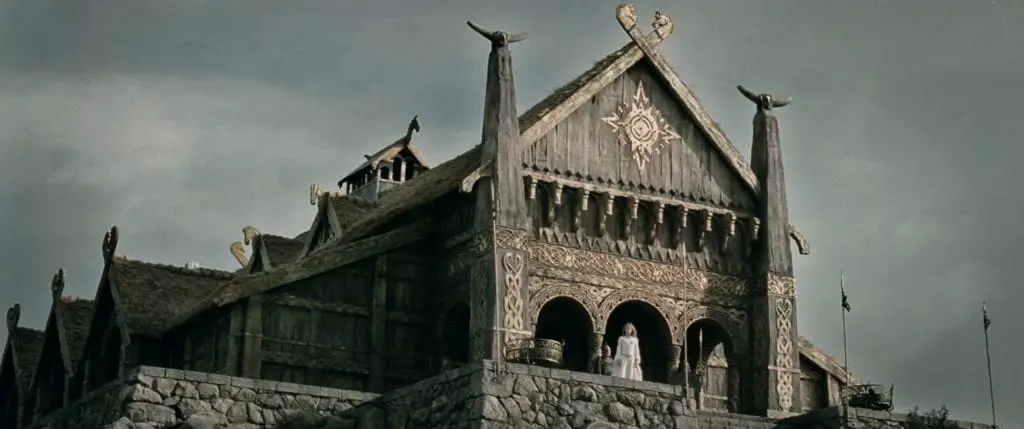
Final Points
- When I wrote at the top that The Two Towers was not a great film I felt an overwhelming need to apologize. Sorry, younger Katie! But I’m not taking it back! I do want to throw in a caveat, though. I do appreciate what Peter Jackson did with these movies. As I said, they will likely always be important to me and hold a place in my heart. I am consistently aware that they could have been so much worse. But at the same time, that seems like an inappropriately low bar to set. They could have been worse! But man, they really could have been better, too.
- Can someone please explain to me why Gandalf, Aragorn, & Co keep telling Théoden to ride out and meet Saruman’s force in open battle? I am not a tactician but that seems like a genuinely terrible idea. As far as I can tell Rohan has about 30 soldiers trained soldiers at its disposal, and when they add the old men and children at Helm’s Deep Legolas confirms them to be at 300. Saruman’s army of 10,000 would have crushed them immediately, right? The references to Eómer and Gondor are fine, but neither would have arrived in time without those solid Helm’s Deep walls to keep the orcs at bay. The decision to retreat to Helm Deep is portrayed as Théoden being “weak,” but I’m pretty sure any open battle would have left everyone dead.
- The Arwen flashback scenes don’t really work for me. They aren’t terrible, but they also appear abruptly two hours into the film and feel disconnected to everything else. Which is a shame, because at its core Arwen’s story is interesting. It involves a genuinely difficult choice, something rare in this film. That said, I do kind of like Elrond’s long, mean, and manipulative monologue. It feels like it’s from a different movie, but in a bombastic sort of way I think it captures a bit of the weight of Arwen’s choice.
- Mytly called it last year! Frodo’s characterization is really starting to hurt his story. There’s a tendency here to portray the Ring’s pressure on Frodo by making him temperamental and snippy. Frodo’s slow slide into apathy and depression seems much more fitting, but it was not a viable choice thanks to Frodo’s quiet passivity throughout Fellowship.
- Eowyn being a bad cook is dumb, unnecessary, and blatantly rooted in lazy tropes. No thank you. But I do enjoy her long, blank stare into the distance when she realizes her crush is 87 years old and has an elf-girlfriend who is sailing away into the west. We’ve all been there, Eowyn.
- My favorite Ridiculous Legolas Stunt in all the movies is not the fabled snowboarding down the stairs at Helm’s Deep, but the unequaled anti-gravity jump onto a horse during the warg attack. I hate it and I love it.
- Aragorn’s warg “death” off the cliff doesn’t do much except make the movie longer. Maybe it worked better for those who hadn’t read the books?
- I’m side-eyeing Rohan a bit for letting eight-year-old boys fight but none of the women.
- Despite my negativity near the end, a lot of the climax still does work for me, largely in part due to my deep love for the core material and Howard Shore’s scoring. I’ll always be a sucker for Bernard Hill yelling “Fell deeds awake. Now for wrath. Now for ruin! And the red dawn!” followed by the horn blast. Good stuff.
- See you in March! It’s finally Return of the King time. <3


